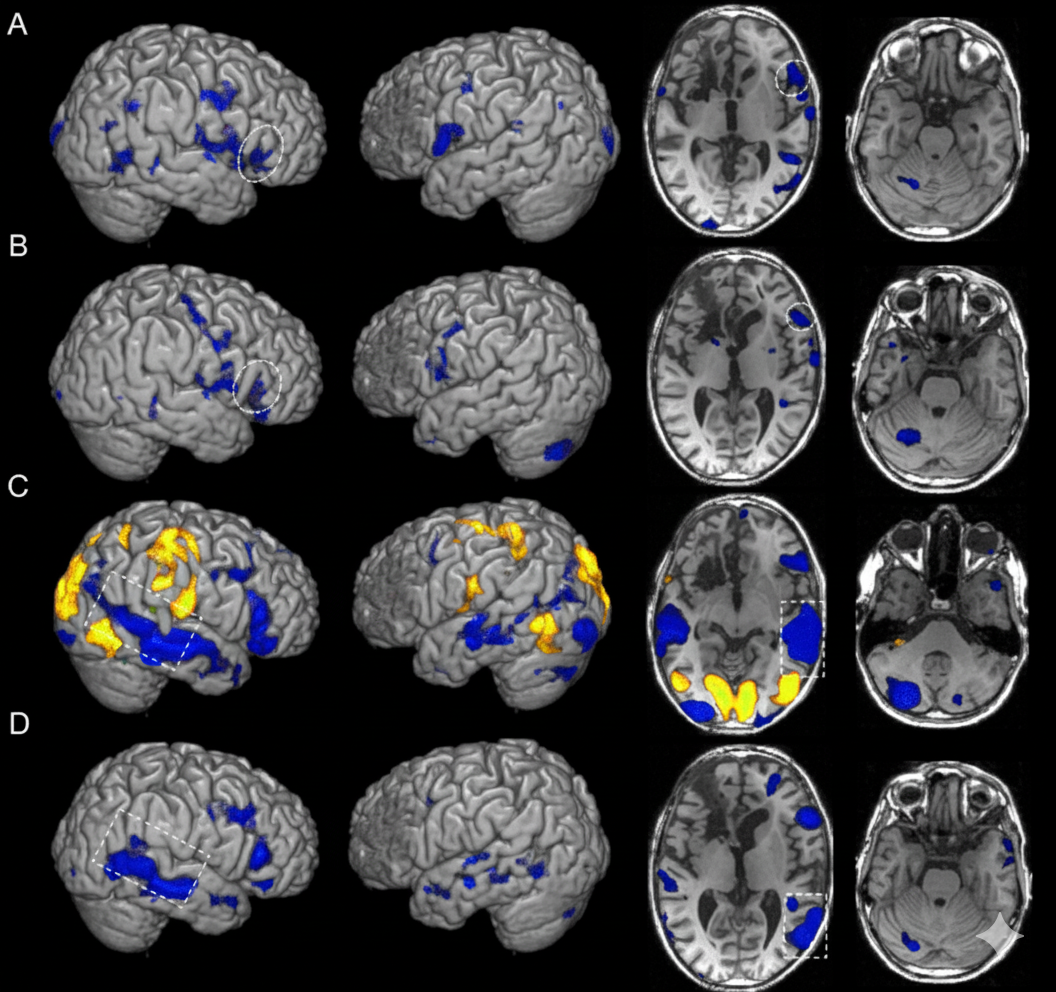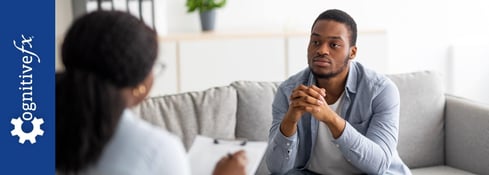A large real-world study demonstrates that using fMRI brain scans to personalize TMS targeting will significantly improve outcomes for treatment-resistant depression—but the treatment works well either way.
If you've been following developments in mental health treatment, you've likely heard about transcranial magnetic stimulation (TMS)—a non-invasive brain stimulation therapy that's been FDA-approved for depression since 2008. But the field has evolved dramatically in recent years, with new "accelerated" protocols that deliver a full treatment course in just five days instead of six weeks.
The question researchers are now grappling with: Does using advanced brain imaging to personalize exactly where we stimulate make a meaningful difference? A new preliminary study published in September 2025 provides the most comprehensive real-world evidence yet—and the answer appears to be yes.
What This Study Examined
Researchers from Acacia Clinic and Harvard University analyzed outcomes from 195 patients with treatment-resistant depression who received accelerated TMS (aTMS) between 2019 and 2025. These weren't carefully selected research participants—they were real patients seeking treatment in a clinical setting, many with multiple failed medication trials and complex medical histories.
The key comparison: 115 patients received fMRI-guided targeting to personalize their treatment, while 80 patients received standard scalp-based targeting (the Beam F3 method, which estimates location based on skull landmarks).
The results were striking: After accounting for baseline differences between groups using sophisticated statistical matching, patients who received fMRI-guided targeting were 2.3 times more likely to respond to treatment. The response rate jumped from 62% with standard targeting to 77.5% with fMRI guidance.
Put another way: for every 6-7 patients who receive fMRI-guided treatment, one additional person achieves significant symptom relief compared to standard targeting.
Understanding the Neuroscience: Why Location Matters
To appreciate why personalized targeting might make such a difference, we need to understand a bit about how TMS works and what it's trying to accomplish.
The Brain Networks Behind Depression
Depression isn't caused by a single brain region "malfunctioning." Instead, it involves disrupted communication between multiple brain networks. One of the most important connections involves:
- The dorsolateral prefrontal cortex (DLPFC): Located behind your forehead, this region is crucial for executive function, emotion regulation, and decision-making
- The subgenual cingulate cortex (SGC): Deep inside the brain, this area is often overactive in depression and involved in processing negative emotions
Think of these regions like two cities connected by a highway. In depression, this highway becomes underactive—the DLPFC isn't properly regulating the SGC's emotional processing. TMS works by stimulating specific spots in the DLPFC to strengthen this connection.
How fMRI Personalizes the Target
Here's where the personalization comes in: everyone's brain is organized slightly differently.
Just as your fingerprints are unique, the precise architecture of your brain's functional networks varies from person to person. The DLPFC is a relatively large brain region that is responsible for many functions, so the "ideal" spot to stimulate within the DLPFC to reach the SGC could be a very different location for you than for someone else.
fMRI (functional magnetic resonance imaging) allows clinicians to map your brain's specific connectivity patterns. During a roughly 20-minute scan, patients simply rest while the MRI measures spontaneous fluctuations in brain activity—seeing how your brain naturally communicates with itself.
The analysis then identifies which locations in your DLPFC show the strongest anti-correlation (negative functional connectivity) with the SGC. This is your personalized target—the precise spot where stimulation is most likely to influence the depression-related network.
The Standard Approach: Beam F3
The DLPFC is a large region with many subregions that do similar, overlapping functions. Most areas of the left DLPFC contribute in lesser and greater degrees to the function of controlling depression. The small spot that is the most anti-correlated with SGC is particularly dedicated to this function, and is the most potent spot to stimulate. However, if you stimulate just about anywhere in left DLPFC, you will likely to get some degree of benefit.
The Beam F3 method, named for the researcher who discovered it, relies on this fact for treating many patients effectively without imaging. This standard method uses skull measurements to estimate where the DLPFC should be, similar to how a tailor might use standard measurements to estimate clothing fit. It accounts for head size variations but doesn't capture the individual differences in where your specific brain networks are located.
What "Accelerated" TMS Actually Means
Traditional TMS protocols involve one treatment session per day, five days per week, for six weeks—a significant time commitment. Accelerated TMS condenses this timeline dramatically:
- Multiple sessions per day (the patients in this study averaged 8-10 sessions daily)
- Treatment completed in just 5 days
- Uses a specific stimulation pattern called intermittent theta-burst stimulation (iTBS)
This acceleration is based on fundamental neuroscience principles. The brain undergoes neuroplastic changes—physical rewiring of neural connections—in response to TMS. By delivering treatments in rapid succession with shorter breaks between them, accelerated protocols may enhance this neuroplasticity through a phenomenon called "spaced learning."
It's similar to how cramming information with short breaks (spaced repetition) can be more effective than spreading study sessions far apart—the neural pathways are strengthened while they're still "active" from the previous session.
The Real-World Results: What the Numbers Mean
Let's break down what the study found in practical terms:
Overall Effectiveness
- 72.8% of all patients responded to treatment within one month (improvement on standardized clinical measures)
- 51.8% achieved remission (very much improved, essentially symptom-free)
- These outcomes occurred despite patients averaging more than 5 previous medication failures
This is remarkable. These weren't ideal candidates with straightforward depression—many had tried numerous treatments, had comorbid conditions, and represented the real complexity of clinical practice.
The fMRI Advantage
When researchers used propensity score matching—a statistical technique that creates "matched pairs" of similar patients who differed primarily in whether they received fMRI guidance—the benefits became even clearer:
- fMRI-guided: 77.5% response rate
- Standard targeting: 62.2% response rate
- Absolute difference: 15.3%
This means that if you treated 100 patients with fMRI guidance instead of standard targeting, approximately 15 additional people would experience significant improvement.
Who Responded Best?
Interestingly, the second best predictor of treatment outcome (after fMRI guidance) was the number of previous antidepressant trials. More prior medication failures predicted lower response rates—highlighting how critical new treatment options like aTMS are for truly treatment-resistant cases.
Age, sex, baseline severity, and history of other brain stimulation treatments didn't significantly predict outcomes, suggesting that aTMS with fMRI guidance may work across a broad range of patient profiles.
Safety Profile: What About Side Effects?
Treatment was generally well-tolerated, with no patients discontinuing due to adverse events. However, there were some important findings:
Common side effects included:
- Headache (61% fMRI-guided, 45% standard)
- Fatigue (31% fMRI-guided, 30% standard)
- Treatment-emergent anxiety (15% fMRI-guided, 7% standard)
Interestingly, the fMRI-guided group experienced more side effects overall, including more frequent headaches, cognitive effects, and treatment-related anxiety. The researchers suggest this might indicate that more precise targeting produces both enhanced efficacy and enhanced side effects—you're stimulating exactly the right circuit, which means you're also more likely to temporarily activate or disrupt nearby networks during treatment.
The good news: most side effects resolved quickly, often within the treatment week itself. The two cases of treatment-emergent anxiety that persisted were successfully managed with additional right-hemisphere stimulation, targeting a different network involved in anxiety. In our clinic, we have had great success managing any potential anxiety with personalized right-hemisphere stimulation as needed.
The Clinical Implications: What This Means for Patients
This study addresses a critical question facing the field: Is the added complexity and cost of fMRI-guided targeting worth it?
The answer from this data appears to be yes—with some important caveats:
For Patients Considering Treatment
- aTMS works well even without fMRI guidance (62% response rate; standard targeting can still activate the right area of the DLPFC in many cases)
- fMRI guidance improves your odds substantially (jumping to 77.5% response)
- The treatment works quickly (most improvement within days to weeks, not months)
- It's appropriate for highly treatment-resistant cases (average 5+ prior medication failures)
The Access Question
Not everyone has access to fMRI-guided TMS. The technology requires:
- An MRI scanner meeting specific quality standards
- Specialized image processing software and expertise
- Neuronavigation equipment to match the MRI brain map to the patient's actual head
- Clinicians trained in connectivity-based targeting
If fMRI-guided targeting isn't available in your area, this study's findings remain encouraging: standard accelerated TMS still produced a 62-66% response rate, which compares favorably to most antidepressant medications and traditional TMS protocols.
Understanding the Study's Strengths and Limitations
What Makes This Study Valuable
1. Real-world data: Unlike highly controlled clinical trials that exclude patients with comorbidities, this study included the messy reality of clinical practice—patients with multiple diagnoses, prior treatment failures, and varying clinical presentations.
2. Large sample size: With 195 patients, this is one of the largest reports of accelerated TMS outcomes to date.
3. Sophisticated statistics: The researchers used propensity score matching to create "apples-to-apples" comparisons between groups that differed in baseline characteristics.
Important Limitations to Consider
1. Not a randomized trial: Patients chose whether to receive fMRI guidance (often based on insurance coverage, schedule constraints, or personal preference). While statistical matching helps, unmeasured confounding factors could still influence results.
2. Potential placebo enhancement: Patients receiving fMRI guidance knew they were getting "advanced" personalized treatment, which might enhance placebo response.
3. Temporal bias: fMRI guidance was introduced midway through data collection, so later patients had different treatment experiences than earlier ones.
4. Single-site study: Results from one specialized clinic may not generalize to all settings.
The gold standard for confirming these findings would be a randomized controlled trial where patients are assigned to fMRI-guided vs. standard targeting. Such a trial is currently underway (NCT07043738), and results are eagerly awaited.
The Neuroscience of Precision Psychiatry
This study represents an important step toward what researchers call "precision psychiatry"—tailoring treatments to individual brain architecture rather than using one-size-fits-all approaches.
The concept builds on decades of neuroscience research showing that:
- Brain networks, not individual regions, drive psychiatric symptoms
- Network organization varies substantially between individuals
- Interventions targeting specific networks may be more effective than region-based approaches
fMRI-guided TMS exemplifies this paradigm. Rather than stimulating a generic "depression region," it identifies and targets the specific circuit dysfunction present in your particular brain.
Comparing Accelerated TMS to Other Depression Treatments
It's helpful to put these response rates in context:
Antidepressant medications:
- First medication trial: ~30-45% response rate
- After 4 failed trials: ~10-15% response rate
Traditional (non-accelerated) TMS:
- ~50-60% response rate in treatment-resistant patients
Electroconvulsive therapy (ECT):
- ~70-80% response rate, but with cognitive side effects
Accelerated TMS (this study):
- 62-77% response rate depending on targeting method
- Completed in 5 days vs 6 weeks
- Minimal cognitive side effects
The speed and tolerability of accelerated TMS are particularly noteworthy. Depression is a time-sensitive condition—suffering has real costs in relationships, work, and quality of life. A treatment that works in days rather than weeks or months represents a meaningful advance.
What About Treatment Durability?
One question this study doesn't fully answer: How long do these improvements last?
The outcomes were measured within one month of treatment completion. While this demonstrates rapid and robust initial response, longer-term follow-up data will be crucial for understanding durability.
Preliminary evidence from other accelerated TMS studies suggests that:
- Most patients maintain improvement for at least several months
- Some require "booster" sessions
- Maintenance treatment protocols are being developed
This is an area where ongoing research is needed, and where personalized approaches (like fMRI-guided maintenance targeting) may prove valuable.
The Future of Brain-Guided TMS
This study opens several exciting research directions:
1. Symptom-specific targeting: Rather than just targeting "depression," could we identify distinct targets for specific symptoms like anxiety, anhedonia (inability to feel pleasure), or cognitive dysfunction?
2. Biomarker development: Can baseline brain connectivity patterns predict who will respond best to treatment?
3. Multi-target protocols: Should some patients receive stimulation to multiple sites based on their specific symptom profile?
4. Optimization of fMRI acquisition: What's the minimum scan time needed? How does scanner quality affect target selection?
5. Integration with other treatments: How does aTMS combine with psychotherapy, medications, or other neuromodulation approaches?
Practical Takeaways for Patients and Clinicians
If You're Considering TMS for Depression:
Questions to ask your provider:
- Do you offer accelerated protocols (multiple sessions per day)?
- Is fMRI-guided targeting available?
- What's your clinic's response rate for treatment-resistant cases?
- How do you monitor and manage side effects?
- What's your protocol if initial treatment isn't sufficient?
What to expect:
- Treatment involves sitting still while a device held against your scalp delivers magnetic pulses
- Each session lasts 3-10 minutes
- You'll feel tapping sensations and some sensitivity on your scalp
- Most people tolerate it well and can drive themselves to/from appointments
- Initial improvement may occur within days, though full response takes longer
For Clinicians:
This study suggests that fMRI-guided targeting offers measurable advantages in response rates, with a number needed to treat of approximately 6.5. However, excellent outcomes can still be achieved with standard targeting when imaging isn't available.
Key implementation considerations:
- Quality standards for fMRI acquisition (20+ minute scans, 3T scanner, specific preprocessing)
- Need for specialized expertise in connectivity analysis and target selection
- Neuronavigation equipment requirements
- Patient counseling about expected side effects (particularly treatment-emergent anxiety with anti-SGC targeting)
- Importance of monitoring and supporting patients post-treatment, especially those at high suicide risk
Conclusion: Personalization Matters, But Access Matters Too
This study adds compelling real-world evidence that fMRI-guided targeting improves outcomes for accelerated TMS in depression. The 15-point improvement in response rate (from 62% to 77.5%) is clinically meaningful and statistically robust.
However, the finding that standard targeting still produced 62-66% response rates is equally important. For the millions of people suffering from treatment-resistant depression, even standard accelerated TMS represents a rapid, effective, and well-tolerated option—particularly for those who've exhausted multiple medication trials.
The ideal scenario, of course, is making fMRI-guided approaches widely accessible. But in the meantime, we can take comfort that accelerated TMS protocols show strong effectiveness regardless of targeting method.
As we move toward more personalized medicine, studies like this illuminate both the promise of precision approaches and the reality that even our "less precise" tools can be remarkably effective when applied thoughtfully.
For patients struggling with treatment-resistant depression: accelerated TMS—with or without fMRI guidance—may offer hope where previous treatments have fallen short.
Schedule Free Consultation
References
DeSouza DD, Meng NF, DeGaetano NP, et al. Naturalistic Outcomes with fMRI-Guided and Non-fMRI-Guided Accelerated TMS for Depression. medRxiv 2025. doi:10.1101/2025.09.03.25334813











